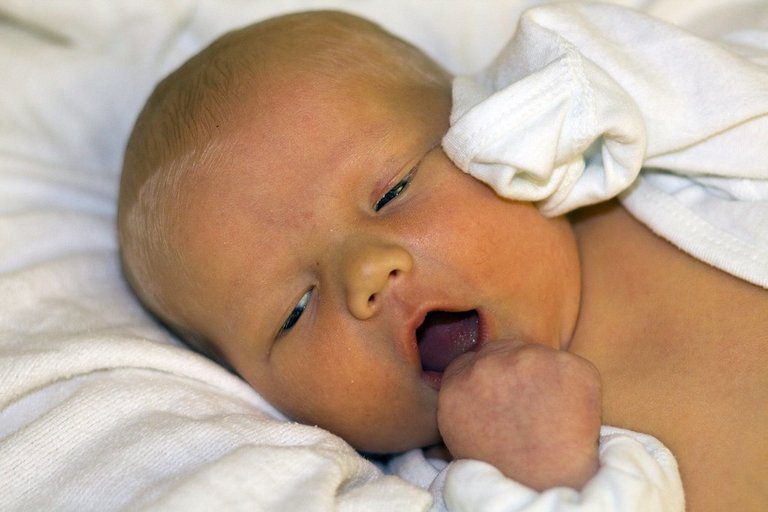I have a social media channel where I talk about mostly home-based celebrity artists and the rumors that surround them, so yesterday I heard information and I quickly set up my video-making apparatus to record a short video even while I was tired to my bone. After recording the video, I was watching as usual to ensure there was no need for editing when I noticed my eyes were not clear at all, infact they looked yellow in that video.
I quickly called my husband to notify him because the first thing that came to my mind was Jaundice, eh, God forbid so I said to myself. When he checked, he confirmed my eye was not yellow physically, but why were they yellow in the video I questioned, please don't lie to me oh, I said, but we went to check the settings of my light and figured out it was tuned to color yellow instead of white. I was relaxed because the good news is, I don't have Jaundice, but what about it?

Image Credit
Jaundice in itself isn't a disease but rather a sign of an underlying health condition, it is the yellow discoloration of the white part of the eye and body fluids. Several medical conditions can cause jaundice, such as tumors, hepatitis, and gallstones.
Jaundice happens basically when the liver is not able to process bilirubin in the blood. Bilirubin is a yellow substance made when red blood cells break down, this could be caused by the presence of excessive red blood cell breakdown or liver injury.
Here is how Jaundice develops, ride along.....
First of all, the body breaks down old red blood cells regularly and then replaces them with new ones, it is this breakdown process that makes room for bilirubin. On a normal day, the liver processes bilirubin and then makes it part of bile, and then the liver releases the bile into the digestive system.
Now, when it happens that the liver is unable to process all the bilirubin produced by the body, or the liver has a problem with releasing bilirubin, that is when jaundice happens.
When there is excessive bilirubin in the blood, it begins to leak into the tissues that surround the blood vessels, when this happens, the affected skin becomes yellow as well as the white part of the eyes. Yellow color is often an indication of jaundice.
We have successfully listed out the process of bilirubin production and how jaundice comes along, jaundice can be a side effect of any of these three phases.
Prehepatic Jaundice: The first phase is before the liver processes bilirubin, in this case, excessive red blood cell breakdown takes over the ability of the liver to filter out bilirubin from the blood. Prehepatic jaundice causes; hemolytic anemias, which is when blood cells are destroyed and removed from the bloodstream before the end of their lifespan, and the other is the breakdown of a large hematoma and its reabsorption into the bloodstream. Caused by; malaria, sickle cell anemia,
Hepatic Jaundice: This happens during the production of bilirubin, this type is when the liver is unable to remove sufficient bilirubin from the blood, this is very common with liver failure. Hepatic jaundice is caused by alcohol-induced hepatitis, autoimmune disorders, viruses including hepatitis A, chronic hepatitis B, and C, and Epstein-Barr virus infection.
Posthepatic Jaundice: Another name is obstructive jaundice, which happens when a blockage stops bilirubin from draining into the bile ducts. Posthepatic jaundice causes; inflammation, gallbladder cancer, pancreatic tumors, and gallstones.
In some cases, jaundice will not show as yellow skin coloration, but it will have other associated symptoms like; chills, fever, pain in the stomach, dark-colored urine, itchy skin, feeling confused or tired, weight loss, and pale-colored poop.
There is no specific treatment for jaundice, the treatment is dependent on what is causing it. If it is the case of a virus, it could spread or become chronic, but in the case of liver failure, complications from liver disease could result in coma or death. If underlying conditions could be treated, then it should get better.
Jaundice has many causes, so it is always difficult to state a specific way to have them treated. However, there are general ways to prevent the possible occurrence of jaundice;
Avoid hepatitis infection by getting vaccinations, using a one-time needle, having safe sex, proper personal hygiene with soap and water.
Maintain a healthy weight.
Stay within recommended alcohol intake.
Manage cholesterol
Avoid herbal supplements.
There was a time I used to think jaundice could only affect children, but certainly, I was wrong with that. The condition can affect both babies and adults alike. Jaundice in newborn babies is called neonatal jaundice.

Image Credit
Most babies are born with lots of red blood cells, and this is because their liver is not fully developed yet, hence bilirubin cannot be processed fast. As a result of this, newborns may experience the symptoms of jaundice a few days after they are born.
Neonatal jaundice are also classified based on their causes;
Premature babies are babies born too early and who are usually unable to poop out bilirubin appropriately.
When a baby and birthing parent have different blood types, it may cause the mother to produce antibodies that breaks down the red blood cell of her baby, this is a case of incompatible blood type that may lead to jaundice.
Breast milk jaundice is when a baby is finding it difficult to breast feed or not getting sufficient breast milk.
Physiological jaundice happens when the liver of the child is not fully formed yet.
Normally, neonatal jaundice shouldn't be a thing of worry. However, bilirubin may build up on an extremely high level causing the baby to experience brain damage known as kernicterus. Parents should see a doctor immediately if their baby experiences; fever, vomiting, arching of their neck and back, consistent high-pitched crying, or inability to feed properly.
Conclusion
Jaundice can affect both newborns and adults, neonatal jaundice is what we call a case of jaundice in newborn babies. For both babies and adults, jaundice could occur as a result of different factors, so it is smart to see a medical expert once any unusual symptom is noticed.
For Further Studies.
https://my.clevelandclinic.org/health/symptoms/15367-adult-jaundice
https://www.healthline.com/health/jaundice-types#outlook
https://www.aafp.org/pubs/afp/issues/2004/0115/p299.html
https://www.medicinenet.com/jaundice_in_adults/article.htm

Hi, I am Tobi, a writer, speaker, relationship blogger, and lover of good music. I love making friends and learning from people. If you want to hear me speak on relationships and general life issues, you can find my YouTube channel where you can watch any episode for free, please do not forget to subscribe, friends. I sincerely appreciate every love I get from here, Kindly do well to keep them coming.
